
Amman is the capital and largest city of Jordan, and the country's economic, political, and cultural center. With a population of 4,536,500, Amman is the largest city in the Levant region, and the sixth-largest city in the Arab world.
Some translators of the biblical book of Deuteronomy translate Pisgah as a name of a mountain, usually referring to Mount Nebo. The word פִּסְגָּה literally means "summit". The region lies directly east of the Jordan River and just northeast of the Dead Sea. Mount Nebo is the highest among a handful of Pisgah summits; an arid cluster of hilltops on the western edge of the Trans-Jordanian Plateau. Arabic names for Pisgah include: Fasga (Phasga), Jabal Siyāgha, Rās as-Siyāgha and Rujm Siyāgha.

The Amman International Stadium is a stadium in Al Hussein Youth City in Amman, Jordan. It is the largest stadium in Jordan. The stadium was built in 1964 and opened in 1968, it is owned by the Jordanian government and operated by the higher council of youth. It is also the home stadium of the Jordan national football team and Al-Faisaly SC. It has a current capacity of 17,619 spectators.
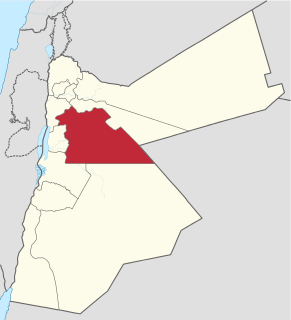
Amman Governorate, officially known as Muhafazat al-Asima, is one of the governorates in Jordan. The governorate's capital is the city of Amman, which is also the country's capital. The administrative center of the governorate as well as all government offices and parliament are located in the Abdali district.
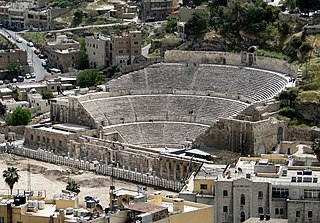
Amman's Roman Theatre is a 6,000-seat, 2nd-century Roman theatre. A famous landmark in the Jordanian capital, it dates back to the Roman period when the city was known as Philadelphia. The theatre and the nearby Odeon are flanking the new Hashemite Plaza from the south and the east respectively, while the Roman Nymphaeum is just a short stroll away in north-westerly direction.

The National Orthodox School-Shmaisani (NOS) is a private, non-profit, co-educational day school in Amman, Jordan, affiliated to Greek Orthodox Christianity. NOS recently became a candidate school for the International Baccalaureate Diploma Programme which it plans to start offering for Grades 11 and 12 students starting the academic year 2018/2019.

Wadi Abdoun is a wadi in Amman, Jordan. The wadi separates the two neighbourhoods of Jabal Amman and Abdoun. The Abdoun Bridge spans the valley, connecting the 4th Circle and Abdoun Circle on either side. Wadi Abdoun is 40 metres (130 ft) deep with a small artery road running under the bridge along the valley floor. The creek in the base of Wadi Abdoun drains to the east, towards Zarqa.
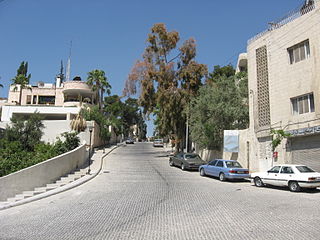
The Rainbow Street, originally named Abu Bakr al Siddiq street, is a public space in the historic area of Jabal Amman, near the center of downtown Amman, Jordan. The street runs east from the First Circle to Mango Street, and contains several attractions from roof top restaurants to pubs. The street runs in front of the British Council building, as well as the headquarters of the Jordan Petroleum Refinery Company and the cinema after which the street is renamed.
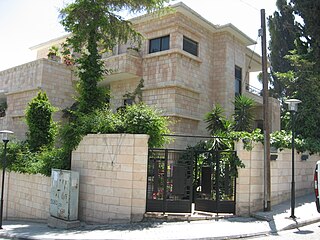
The Mango House is a building in Amman, Jordan. Situated on Mango Street, the house looks out toward Jabal Akhddar on the other side of the valley that is downtown Amman.
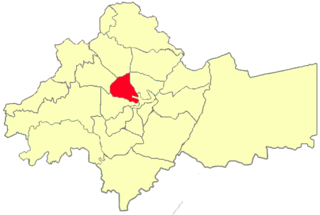
Abdali is an area in the Greater Amman Municipality, it is named relative to King Abdullah I who founded it during the 1940s. It covers an area of 15 square kilometres (6 sq mi) in the heart of Amman, with a population of 165,333 in 2015. Large parts of the district are residential, but due its geographical location in the center of the city, it contains several important governmental buildings and businesses. The area is known for containing several bus stations serving routes to many cities in Jordan.

The Amman Citadel is a historical site at the center of downtown Amman, the capital of Jordan. The L-shaped hill is one of the seven hills (jabals) that originally made up Amman.
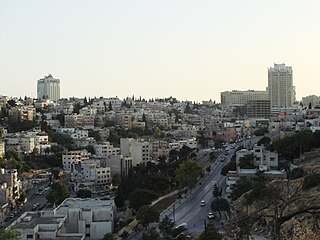
Jabal Amman neighborhood is one of the seven hills that originally made up Amman, Jordan. Today, Jabal Amman is near the downtown area.
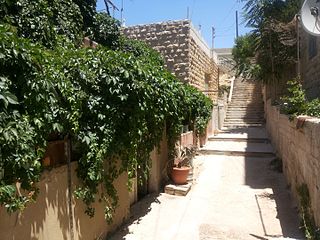
Armenians in Jordan are ethnic Armenians living within the current Hashemite Kingdom of Jordan. There are an estimated 3,000 Armenians living in the country today with an estimated 2,500 of them being members of the Armenian Apostolic Church, and predominantly speak Western Armenian dialect. Armenians make up the biggest majority of non-Arab Christians in the country.
Rujm is an Arabic word that appears as an element in numerous place names. It can be translated as "mound, cairn, hill, spur", and also as "stone heap" or "tumulus". The following is a list of place names that include Rujm as an element:
The following is a timeline of the history of the city of Amman, Kingdom of Jordan.

The Umayyad Palace is a large palatial complex from the Umayyad period, located on the Citadel Hill of Amman, Jordan. Built during the first half of the 8th century, it is now largely ruined, with a restored domed entrance chamber, known as the "kiosk" or "monumental gateway".

Zahran is an area in the Greater Amman Municipality. It is named after the Zahran Palace which stands amidst Zahran street. It consists of 5 neighborhoods of which most parts are residential, however, some parts of the district contain Amman's best hotels, hospitals and towers. The district is also home to several governmental buildings, embassies, cultural centers and schools. Zahran area stretches from 1st circle to between 5th and 6th circles, and from North Abdoun to South Abdoun.

Belbeisi Palace is a historic palace located in Amman, Jordan, in the first circle in Jabal Amman. It was the property of Ismail Pasha Bilbeisi, who came from the town of Salt to Amman in the 1920s. The building was one of the first palaces in the kingdom and now serves as a museum of traditional arts. It is considered one of the finest examples of traditional Arab architecture in Amman. King Abdullah I, the first monarch of Jordan, used it to entertain guests.

The St. Joseph's Church, also alternatively called "Latin Church of Jabal Amman", is a religious building belonging to the Catholic Church in Amman, the capital of the Hashemite Kingdom of Jordan.
















